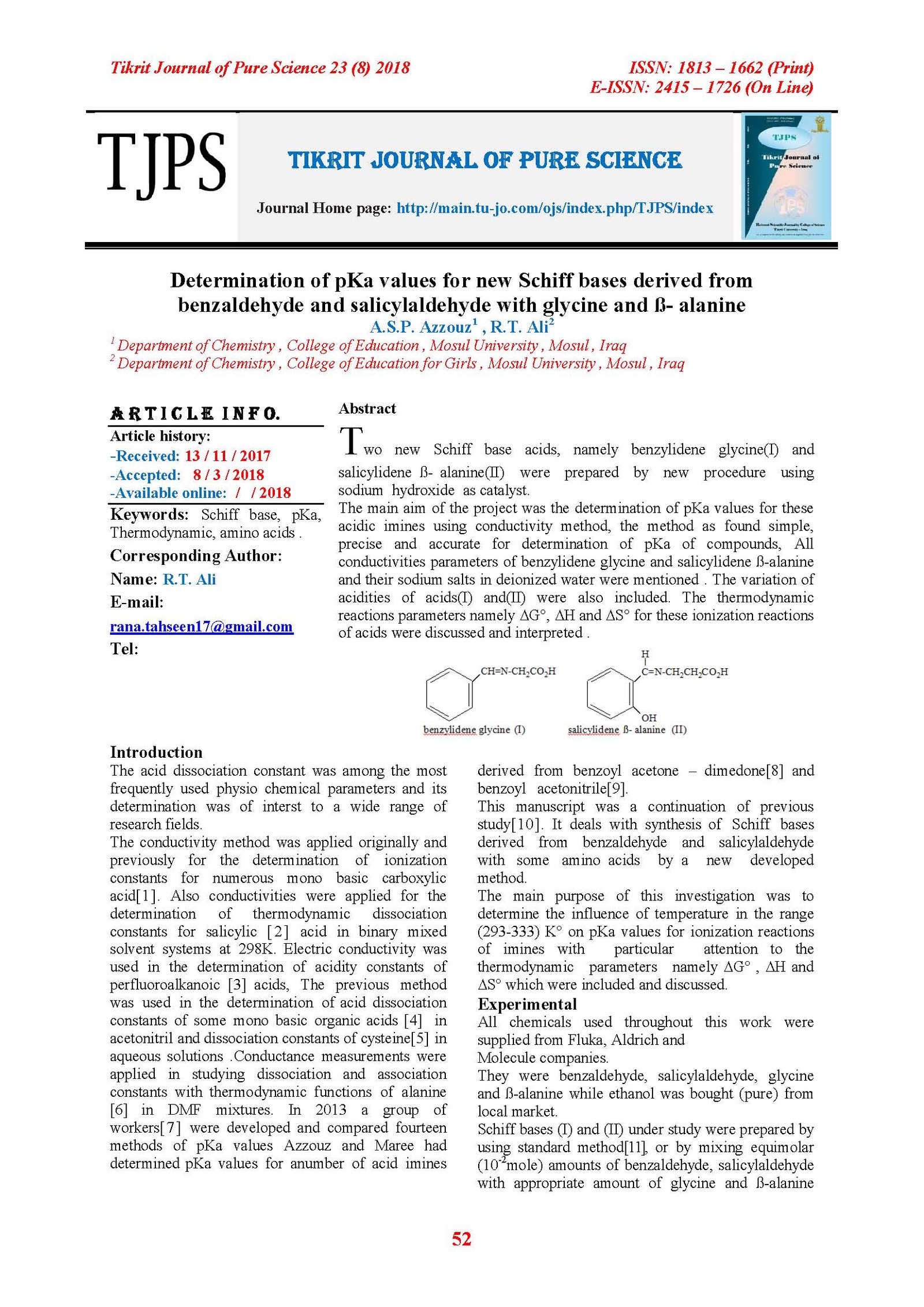Determination of pKa values for new Schiff bases derived from benzaldehyde and salicylaldehyde with glycine and ß- alanine
Main Article Content
Abstract
Two new Schiff base acids, namely benzylidene glycine(I) and salicylidene ß- alanine(II) were prepared by new procedure using sodium hydroxide as catalyst.
The main aim of the project was the determination of pKa values for these acidic imines using conductivity method, the method as found simple, precise and accurate for determination of pKa of compounds, All conductivities parameters of benzylidene glycine and salicylidene ß-alanine and their sodium salts in deionized water were mentioned . The variation of acidities of acids(I) and(II) were also included. The thermodynamic reactions parameters namely ∆G°, ∆H and ∆S° for these ionization reactions of acids were discussed and interpreted .
Article Details

This work is licensed under a Creative Commons Attribution 4.0 International License.
Tikrit Journal of Pure Science is licensed under the Creative Commons Attribution 4.0 International License, which allows users to copy, create extracts, abstracts, and new works from the article, alter and revise the article, and make commercial use of the article (including reuse and/or resale of the article by commercial entities), provided the user gives appropriate credit (with a link to the formal publication through the relevant DOI), provides a link to the license, indicates if changes were made, and the licensor is not represented as endorsing the use made of the work. The authors hold the copyright for their published work on the Tikrit J. Pure Sci. website, while Tikrit J. Pure Sci. is responsible for appreciate citation of their work, which is released under CC-BY-4.0, enabling the unrestricted use, distribution, and reproduction of an article in any medium, provided that the original work is properly cited.
References
[1] Bray, L.G.; Dippy J.F.J.; Hughes, S.R.C. and Laxton, L.W. (1957). Journal Chem. Soc., 2405.
[2] M.S.K. NiaZi, S.S. Shah and M.Z.I. Khan, J. Chem. Eng. Data, 1993, 38:288.
[3] Moroi, Y.; Yano, H.; Shibata, O. and Yonemitsu, T. (2001). Bull. Chem. Soc. Japan, (74): 667.
[4] Nag, S. and D. Datta, (2007). Indian J. Chem., 46(A):1263.
[5] AL-Taiar, A.H.; Bhaya, N.D.; Ridha, S.H.; AL-Sammarrie, H.B. and ALFakhry, K.A. (2007). IBN AL-HAITHM Pure and Appl. Sci., 20(1):100.
[6] Abd, A.N.; AL-Messlmawy, H.A.J.; AL-Jeelo M.S.S. and Farhan, A.M. (2010). AL- Musansiriya Journal Sciences, 21(4):89.
[7] Reijenga, J.; Hoof, A.V.; Loon, A.V. and Teunissen, B. (2013). Analytical Chemistry Insights, (8):53.
[8] Azzouz, A.S.P. and Maree, F.H. (2010). Journal Education Sciences, 23(3):17.
[9] Azzouz, A.S.P.; AL-Abady, R.T.Gh. and AL-Niemi, M.M.H. (2014). Phy. Chem. An Indian Journal, 9(3):92.
[10] Azzouz, A.S.P. and Ali, R.T. (2010). Nat. Journal Chem., (37):158.
[11] Vogel, A.I. (1978). Text Book of practical Organic Chemistry, 4th edn., Longman:847.
[12] AL Masinnes, D. (1961). The principle of Electro Chemistry, Dover, New York.
[13] Martin, A. (1993) physical, pharmacy, 4th edn., Lea and Febiger, London.
[14] Azzouz, A.S.P. and Maree, F.H., (2008). Journal Education Sciences, 21(1):1.
[15] Azzouz, A.S.P.; AL-Niemi, M.M.H. and AL-Abady, R.T. Gh. (2013). Journal Education Sciences, 26(4):39.
[16] Albert, A. and Serjeant, E.p. (1984). The Determination of Ionization constant, 3ed edn., Chapman and Hall, London:161.
[17] Pimertal, G.C. and Mecellellan, A.L. (1960). The Hydrogen Bond, Freeman, San Francisco, New York.
[18] Azzouz, A.S.P.; (2002). Phys. Chem., (216): 1053.
[19] Azzouz, A.S.P. and Sulaman, R.D. (2013). Asian Journal Chem., 25(10):5303.
